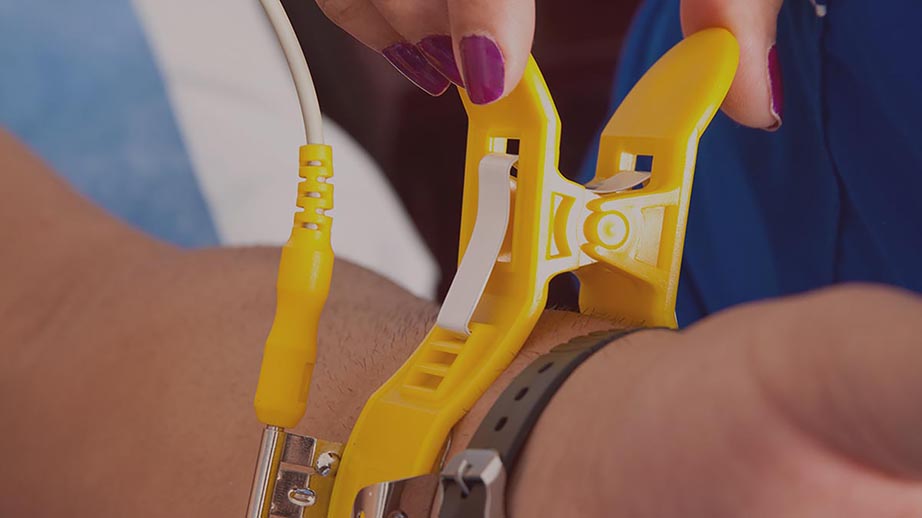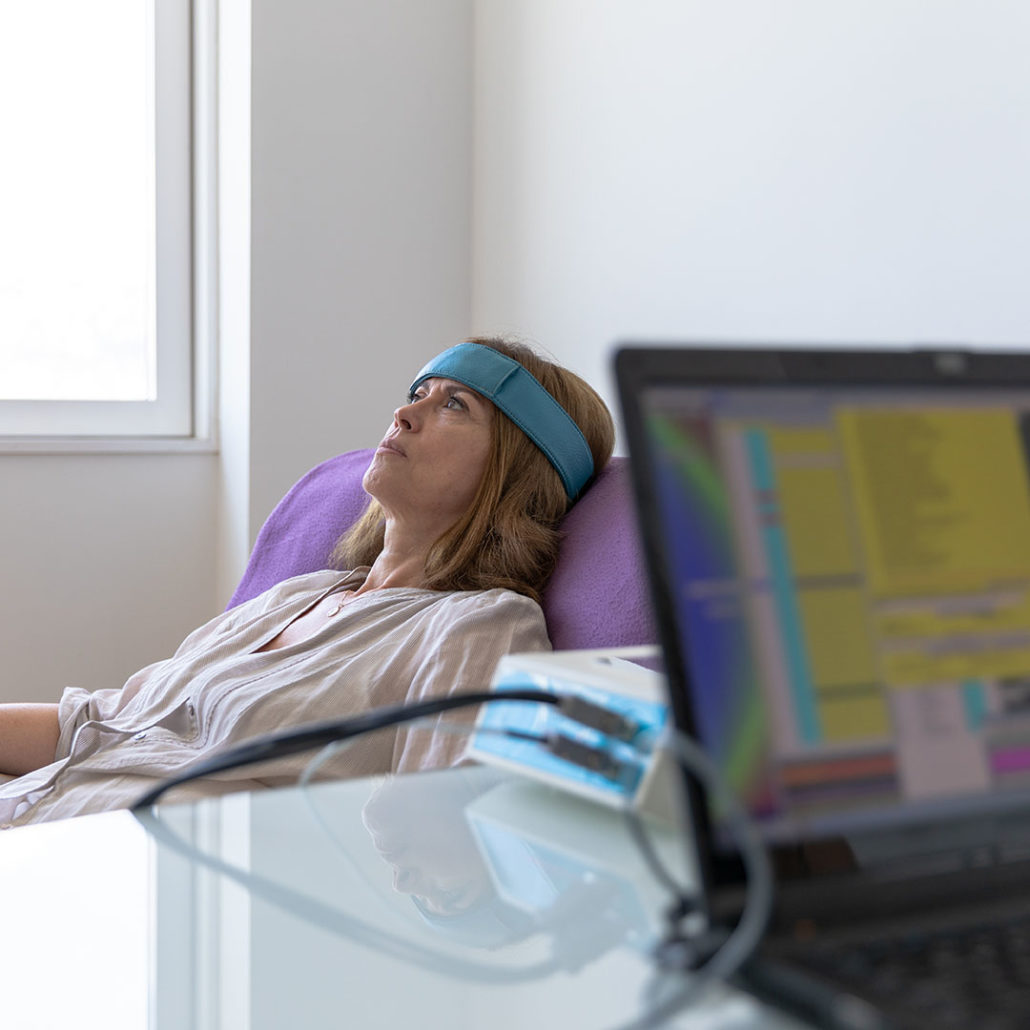Biofeedback Therapy
Technology that helps retrain yourself and promotes a more effective mental and physical response to stress.

Technology that helps retrain yourself and promotes a more effective mental and physical response to stress.
Biofeedback therapy is a non-invasive treatment technique that involves using technology to retrain patients to control involuntary physiological and neurological processes that are causing symptoms and leading to dysfunctions in the body such as muscle tension, blood pressure, or irregular heartbeat. The purpose of biofeedback is to promote a more effective mental and physical response to stress. Stress has been shown to impact nearly every system and organ in the body and is a contributor to a vast number of chronic illnesses.
There are several different biofeedback methods including:
Clinical experience has shown that biofeedback therapy may be used for a number of conditions and issues and that the benefits include:
Biofeedback therapy works by altering one’s awareness/consciousness of how the mind interacts with the body (a field of science known as Psycho-Neuro-Immunology / PNI, or Psycho-Neuro-Endocrine-Immunology / PNEI), adjusting states of arousal and improving the ability to respond effectively to stress and mental activity.
Each cell in our body vibrates at precise frequencies and exchanges information through the communication of these frequencies. Therefore, we have the ability through specialized scientific bioresonance techniques to detect and correct bioenergetic imbalances in the body. Biofeedback is one of the therapies available to help correct a patient’s imbalances and physiological impulses.
The major appeal of biofeedback is that it pre-emptively teaches the patient a set of skills that can be used for life – without side effects. For example, it allows patients to identify early signs of stress so that corrections may be made before biochemical actions are triggered and physical symptoms occur.
During a biofeedback session, electrodes are attached to the skin at multiple locations, and finger sensors may often be utilized. These electrodes/sensors send signals to a monitor, which displays a sound, flash of light, or image that represents heart and breathing rate, blood pressure, skin temperature, sweating, or muscle activity.
When under stress, these physiological functions will fluctuate. Any number or combination of chain reactions may occur, including increased heart rate, elevated blood pressure, perspiration, quickened breathing, etc. These fluctuating functions are presented to the patient on the monitor, and then a practitioner guides or coaches a patient to correct the fluctuations. Over time, a practitioner may select a number of relaxation exercises that will help to fine-tune bodily functions and reactions, and can be used to alleviate symptoms and health complaints of the patient. The aim is to calm the body’s autonomic nervous system, which raises blood pressure and heart rate during periods of stress.
Most biofeedback therapy sessions take about 30 to 60 minutes. The treatment usually lasts two to three months in order to provide the most benefits.
Several different relaxation exercises are used in biofeedback therapy, including:

“The literature, which lacks any negative study of substance, suggests that EEG biofeedback therapy should play a major therapeutic role in many difficult areas. In my opinion, if any medication had demonstrated such a wide spectrum of efficacy, it would be universally accepted and widely used.”
FRANK DUFFY, MD
According to a study published by The Institute of Psychiatry at King’s College, London, biofeedback therapy has been used with great results to treat disorders such as anxiety, autism, depression, eating disorders and schizophrenia. The research was based on over 60 studies which showed that in a majority of cases, the level of clinical symptoms decreased as a result of biofeedback exposure.
source: Biofeedback for Psychiatric Disorders: A Systemic Review, Applied Psychophysiology, and Biofeedback, 2014
Biofeedback therapy is considered a well-established treatment modality for patients with migraine and tension-type headaches. In fact, headaches are one of the best-studied biofeedback uses. ”Multiple published studies have suggested that biofeedback is effective in reducing the frequency and severity of headaches, often allowing patients to decrease their dependence on medication. Studies have also suggested that biofeedback may effect a decrease in medical utilization”.
source: Efficacy of biofeedback in the treatment of migraine and tension-type headaches, Harvard Vanguard Medical Associates, 2009
Some researchers consider Biofeedback therapy as a non-pharmacological technique for controlling both acute and chronic pain. According to a study published by Polish Instytut Neuromedica, it could take about 40 to 60 training sessions to achieve the most benefits. Some studies show this amount can result in up to 50% less pain depending on the condition.
At the New York Center of Innovative Medicine, biofeedback therapy through advanced systems is an option among many different treatments considered for each patient. However, the use of this therapy is only performed on patients after an in-depth initial evaluation reveals it would be necessary for your personalized program of treatment. Because each person is unique, and their health needs are different, there is no set protocol for using biofeedback therapy nor is the patient able to request the use of this therapy if the medical team finds it would not be as helpful as another treatment or specific combination of therapies. The ultimate goal is the complete restoration of health in the most efficient and safe manner, and with so many therapeutic options, it is impossible to know if biofeedback therapy is right for you without an initial evaluation at our clinic.
Contact NYCIM and Book Your Appointment Today
or
» Take Our Questionnaire to See if You’re a Good Candidate
or
» See Additional NYCIM Services & Therapies
We’ll send you a 24 page intro guide and more on how to heal smarter.

 BioCharger Therapy
BioCharger Therapy
Trackbacks & Pingbacks
[…] to balance energy), acupuncture, or reiki. On an emotional level, techniques like neuro- or biofeedback, EFT, NET, meditation, or daily affirmations can assist with lowering levels of anger, frustration, […]
[…] additional diagnostic tests are required (such as lab tests or biofeedback evaluation), the patient will be informed of this after the initial […]
Leave a Reply
Want to join the discussion?Feel free to contribute!